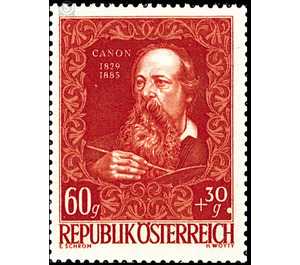80 years - Austria / II. Republic of Austria 1948 - 1.40 Shilling
Theme: Well-known people
| Country | Austria / II. Republic of Austria |
| Issue Date | 1948 |
| Face Value | 1.40 |
| Color | red |
| Printing Type | Typography |
| Stamp Type | Commemorative |
| Item Type | Stamp |
| Chronological Issue Number | 225 |
| Chronological Chapter | OOS-OE2 |
| SID | 248900 |
| In 28 Wishlists | |
On this brand we see the head of the painter Hans Canon actually called Hans von Straschiripka. He was born on March 13, 1829 in Vienna, attended the Academy, but in 1848 soldier and returned to painting in 1855. Above all Karl Rahl and the study of old masters, above all Rubens, gave from then on the decisive influence for his future work. From 1860-1869 he lived in Karlsruhe, where the "Rüdenmeister", the "Schatzgräber" and the historical painting "Chromwall on the corpse Karl I." originated. The sensation caused by his painting "Loge Johannis" at the Vienna World's Fair in 1873 (bought by Emperor Franz Josef) prompted him to return home. Soon he was next to Makart the most famous painter of Vienna. In the Künstlerhaus he exhibited his brilliant portraits from the distinguished Viennese society for years, for the staircase of the Natural History Museum he created the colossal painting "cycle of life". The gifted and unconventional artist died on September 12, 1885.


